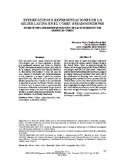| dc.rights.license | http://creativecommons.org/licenses/by-nc-sa/3.0/ve/ | es_VE |
| dc.contributor.author | Plascencia Flores, Evelyn Esmeralda | |
| dc.contributor.author | García Pereyra, Rutilio | |
| dc.contributor.author | Ariza Ampudia, Silvia Verónica | |
| dc.date.accessioned | 2020-11-20T16:29:22Z | |
| dc.date.available | 2020-11-20T16:29:22Z | |
| dc.date.issued | 2020-11 | |
| dc.identifier.issn | 0798-1570 | |
| dc.identifier.uri | http://www.saber.ula.ve/handle/123456789/47094 | |
| dc.description.abstract | Este artículo tiene como objetivo mostrar
estereotipos que se han asignado a latinos,
principalmente mujeres que viven en Estados
Unidos. Mediante un análisis a través de la retórica
de la imagen (propuesto por Roland Barthes)
se detectaron estereotipos y roles de ama de
casa, sumisa y obediente que tradicionalmente
se han asignado a la mujer a partir de posturas
masculinas que sobresalen en la publicación de
dibujos animados aún y cuando se ha considerado
la igualdad de género en Estados Unidos, además
se detectó que la proyección o representación
femenina es altamente sexualizada en que destaca
la figura del cuerpo y el rostro de la mujer latina en
alusión a la mujer ideal que han diseñado revistas
para caballeros en la Unión Americana. | es_VE |
| dc.language.iso | es | es_VE |
| dc.rights | info:eu-repo/semantics/openAccess | es_VE |
| dc.subject | Cómic | es_VE |
| dc.subject | Representación | es_VE |
| dc.subject | Roles | es_VE |
| dc.subject | Estereotipos | es_VE |
| dc.subject | Sexualidad | es_VE |
| dc.subject | Retórica | es_VE |
| dc.title | Estereotipos y representaciones de la mujer latina en el cómic estadounidense | es_VE |
| dc.title.alternative | Stereotypes and representations of latin women in the american comic | es_VE |
| dc.type | info:eu-repo/semantics/article | es_VE |
| dcterms.dateAccepted | Mayo-2020 | |
| dcterms.dateSubmitted | Marzo-2020 | |
| dcterms.publisher | SaberULA | |
| dc.description.abstract1 | This article aims to show stereotypes that have
been assigned to Latinos, mainly women living in
the United States. Whit an analysis through the
rhetoric of the image (proposed by Roland Barthes)
stereotypes and roles of housewife, submissive
and obedient that traditionally have been assigned
to women from male positions that stand out in
the publication of drawings were detected even
though gender equality has been considered in the
United States, it was also detected that the female
projection or representation is highly sexualized in
that it highlights the figure of the body and face of
the Latin woman in reference to the ideal woman
they have designed by men’s magazines in USA. | es_VE |
| dc.description.colacion | 97-109 | es_VE |
| dc.description.email | cifranueva@ula.ve | es_VE |
| dc.description.email | rutiliog@gmail.com | es_VE |
| dc.description.frecuencia | Semestral | |
| dc.description.paginaweb | http://www.saber.ula.ve/cifranueva/ | |
| dc.identifier.depositolegal | P P92-0047 | |
| dc.identifier.edepositolegal | ppi 201202ME4019 | |
| dc.identifier.eissn | 2244-8438 | |
| dc.publisher.pais | Venezuela | es_VE |
| dc.subject.institucion | Universidad de Los Andes | es_VE |
| dc.subject.keywords | Comic | es_VE |
| dc.subject.keywords | Representation | es_VE |
| dc.subject.keywords | Roles | es_VE |
| dc.subject.keywords | Stereotypes | es_VE |
| dc.subject.keywords | Sexuality | es_VE |
| dc.subject.keywords | Rhetoric | es_VE |
| dc.subject.seccion | Cifra Nueva: Artículos | es_VE |
| dc.subject.tipo | Artículos | es_VE |
| dc.type.media | Texto | es_VE |


